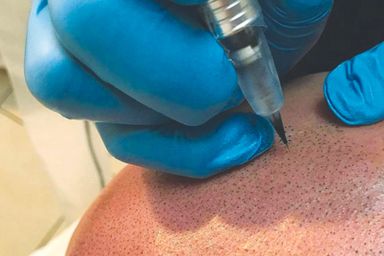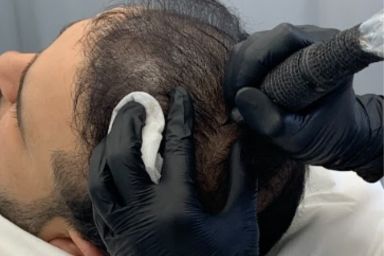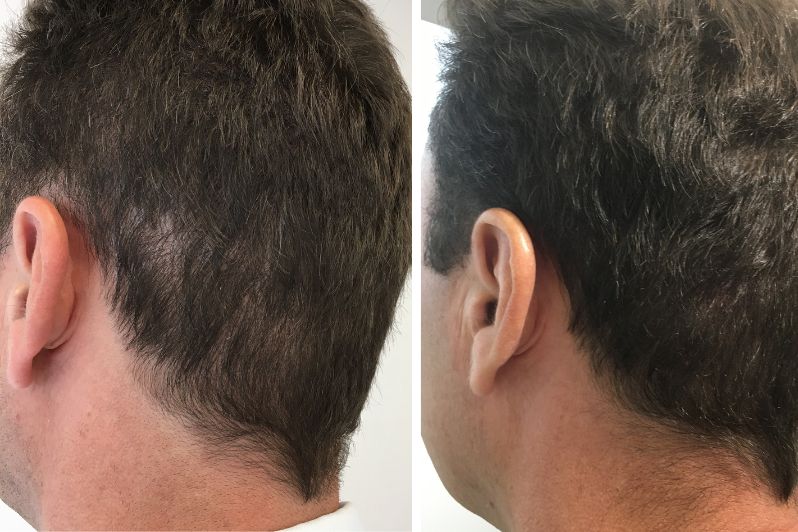Established for over 25 years
Clinics Nationwide
5 Star Google & Trustpilot Reviews
Can You Use Minoxidil with Scalp Micropigmentation?

Reading time: 5 min
Hair loss is a common concern affecting millions globally, impacting both men and women. While the reasons for hair loss vary, the desire to find effective solutions remains constant. Two popular options that have gained significant traction are Minoxidil and Scalp Micropigmentation (SMP).
This article delves into these approaches, exploring their individual benefits, and addressing the crucial question: can you combine Minoxidil and SMP for enhanced results and what is the safe protocol when combining the two.
Table of Content
Minoxidil has been used for hair loss treatment for several decades. The medication affects follicular cells by enhancing hair growth and reducing hair loss. (1)
However, Minoxidil is not a cure, and its effectiveness varies from person to person. It requires consistent use for several months to see noticeable results, and discontinuing its use leads to hair loss reversal.
Additionally, Minoxidil can cause side effects like scalp irritation, itching, and facial hair growth. (2)
The oral form of Minoxidil requires a prescription, similar to the 5% topical version. However, the 2% topical variant is available over the counter.
Scalp Micropigmentation (SMP) offers a visual solution for thinning hair, bald patches, or disguising scars, in contrast to Minoxidil, which is aimed at stimulating hair growth. Providing immediate results, SMP serves as a natural-looking, low-maintenance alternative to surgical hair loss treatments. However, it is important to note that SMP requires touch-up sessions every few years to maintain its appearance.
This non-surgical method involves the application of tiny dots of pigment onto the scalp, effectively creating the illusion of thicker, denser hair. By simulating the appearance of actual hair follicles, SMP offers an effective way to conceal hair loss without encouraging new hair growth, unlike Minoxidil.
Before and after results showing different types of Scalp Micropigmentation treatment on men and women
Many individuals experiencing hair loss wonder if they can combine Minoxidil and SMP for optimal results. The answer is yes, but with important considerations:
Stopping Minoxidil before SMP
To ensure optimal results for your SMP procedure, it's recommended to stop using Minoxidil 48 hours beforehand. Minoxidil promotes blood flow, and for the procedure, we need the scalp to be stable. Additionally, topical Minoxidil is alcohol-based, which can hinder pigment retention. Stopping Minoxidil 48 hours in advance allows for two hair washes to remove any residual alcohol from the scalp.
Resuming Minoxidil after SMP
Topical Minoxidil: Discontinue use until 7 days after your SMP treatment. This allows the pigment time to settle in the skin. Applying Minoxidil too soon can hinder pigment retention, impacting long-term results.
Oral Minoxidil: You can resume using oral Minoxidil immediately after your treatment.
Application of Minoxidil on Micropigmented Scalp
When applying Minoxidil to a micropigmented scalp, use a gentle touch and avoid harsh rubbing. Opt for foam-based formulations that are less likely to irritate the scalp.
Combining Minoxidil and SMP can offer several potential benefits:
- Enhanced hair growth: Minoxidil may stimulate new hair growth, complementing the visual density achieved by SMP.
- Addressing different aspects of hair loss: Minoxidil targets hair growth, while SMP addresses the appearance of hair density.
However, there are also potential risks to consider:
- Minoxidil affecting SMP pigment: During the healing phase, Minoxidil might slightly affect the settling of the SMP pigment, requiring potential adjustments by the practitioner.
- Increased scalp sensitivity: The combination can increase scalp sensitivity, requiring extra care and gentle product application.
Closely monitoring your scalp after resuming Minoxidil use post-SMP is crucial. Watch for any signs of irritation, redness, or infection. If you experience any discomfort or concerns, consult your SMP practitioner immediately.
Conclusion
Minoxidil and Scalp Micropigmentation (SMP) address hair loss differently. Minoxidil promotes growth, while SMP aims to conceal hair loss. Combining them can be beneficial, but requires caution. Pausing Minoxidil before and after SMP is key, and gentle application is crucial. Potential benefits include boosted growth and improved density, but increased scalp sensitivity and pigment interaction are possible risks.
Is it safe to combine Minoxidil with other hair loss treatments like Finasteride alongside SMP?
Combining Minoxidil with other hair loss treatments like Finasteride alongside SMP can be safe, but it's crucial to consult your dermatologist or SMP practitioner first. They can assess your individual situation and advise on the suitability and potential interactions of these treatments.
What are the long-term maintenance requirements for both Minoxidil and SMP?
- Minoxidil: Requires consistent daily application to maintain results. Stopping its use will lead to hair loss reversal.
- SMP: Requires touch-up sessions every few years to maintain optimal results.
Does Scalp Micropigmentation damage existing hair follicles?
The answer is no. SMP is a non-invasive procedure that deposits pigment in the upper layers of the scalp, far above the location of hair follicles residing deeper in the skin. Microscopic needles create tiny pigment deposits, minimising disruption to surrounding tissues, including follicles.
Choosing a qualified practitioner is crucial though. Improper technique or unsuitable pigments could potentially lead to complications, although damaging hair follicles is not a typical concern.
Sources


Article author Dawn Forshaw — Published on 29th February 2024

Does Scalp Micropigmentation Damage Hair Follicles?

Scalp Micropigmentation Aftercare: A Comprehensive Guide

Scalp Micropigmentation Fading: A Comprehensive Guide

Celebrities With Scalp Micropigmentation

Is Scalp Micropigmentation Permanent?

Combining Scalp Micropigmentation and Hair Transplants: The Ultimate Hair Loss Solution

Botched Scalp Micropigmentation Treatment: What Are Your Options?

Eyebrow Hair Loss Demystified: Uncovering Causes and Pursuing Solutions

Female Temple Hair Loss: Causes, Prevention & Treatment
- Choosing a selection results in a full page refresh.
- Press the space key then arrow keys to make a selection.




